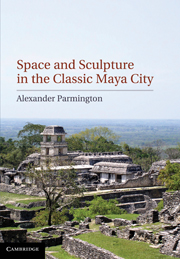Book contents
- Frontmatter
- Contents
- List of illustrations
- List of tables
- Summary
- Acknowledgements
- Introduction
- 1 Defining the Maya built environment
- 2 Investigative considerations and methodology
- 3 Access analysis of the Palenque Cross Group and its sculpture
- 4 Architectural and sculptural programs of the Palenque Palace Group
- 5 Access analysis of the architectural and sculptural programs of the Palenque Palace Group
- 6 Access analysis of Maya art and architecture: Summary and conclusions
- Appendixes 1–7
- Bibliography
- Index
5 - Access analysis of the architectural and sculptural programs of the Palenque Palace Group
Published online by Cambridge University Press: 05 August 2011
- Frontmatter
- Contents
- List of illustrations
- List of tables
- Summary
- Acknowledgements
- Introduction
- 1 Defining the Maya built environment
- 2 Investigative considerations and methodology
- 3 Access analysis of the Palenque Cross Group and its sculpture
- 4 Architectural and sculptural programs of the Palenque Palace Group
- 5 Access analysis of the architectural and sculptural programs of the Palenque Palace Group
- 6 Access analysis of Maya art and architecture: Summary and conclusions
- Appendixes 1–7
- Bibliography
- Index
Summary
Access analysis of the Palace Phases 1–6
As outlined at the beginning of Chapter 4, the first stage of the Palace Group investigation required that I establish a relative chronology of Palace buildings at Palenque, followed by the breaking up of the proposed sequence of construction into phases that correspond to the reigns of the kings. My objective in doing this was to more clearly articulate the various architectural and sculptural programs of the Palace as well as to provide a platform for inferring the intent of different rulers in the placement of certain sculpture within specific spatial contexts. In Chapter 4, six maps of the Palenque Palace were presented, each representing different stages in the evolution of the building group. These maps were used to construct a series of “access diagrams” that were implemented to hierarchically order and interpret the “spaces” and corresponding sculpture of each Palace phase (see Appendix 3, Palenque Palace Sculpture Phases 1–6). Using various techniques in “access analysis,” in addition to the “thematic–analytical” inquiry of monumental art, my goal was to detect shifts in the content and placement of Palace Group sculpture over time and through space, as prescribed by changes in corresponding “carrier depths,” “relative asymmetry” (RA), and “control value” calculations. General questions that I address in this chapter are: (1) Is there specific sculpture marking certain types of spaces? (2) What may have motivated the apparent strategic placement of fixed sculpture media in Maya city centres?
- Type
- Chapter
- Information
- Space and Sculpture in the Classic Maya City , pp. 134 - 173Publisher: Cambridge University PressPrint publication year: 2011



